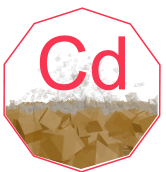Cadmium

Cadmium (Cd)
General Information
- Symbol: Cd
- Atomic Number: 48
- Atomic Weight: 112.414 u
- Element Category: Transition metal
- Group: 12
- Period: 5
- Block: d-block
Physical Properties
- Appearance: Silvery-blue metallic
- Density: 8.65 g/cm³
- Melting Point: 321.07 °C (609.93 °F)
- Boiling Point: 767 °C (1413 °F)
- Phase at STP: Solid
- Electron Configuration: [Kr] 4d¹⁰ 5s²
- Oxidation States: +2 (most common), +1
Chemical Properties
- Reactivity: Relatively low reactivity; does not tarnish in air but forms a layer of cadmium oxide (CdO).
- Compounds: Forms compounds such as cadmium sulfide (CdS), cadmium oxide (CdO), and cadmium chloride (CdCl₂).
Uses and Applications
- Batteries: Used in nickel-cadmium (NiCd) rechargeable batteries.
- Pigments: Used in cadmium pigments such as cadmium yellow (CdS) and cadmium red (CdSe).
- Electroplating: Used in electroplating to provide a corrosion-resistant layer.
- Nuclear Reactors: Used as a neutron absorber in control rods.
- Alloys: Combined with other metals to form low-melting alloys for soldering and brazing.
Occurrence and Extraction
- Natural Occurrence: Found in zinc ores such as sphalerite (ZnS) and also in greenockite (CdS).
- Extraction: Extracted as a byproduct of zinc refining through processes involving roasting, reduction, and purification.
Isotopes
- Stable Isotopes: Cadmium-106, Cadmium-108, Cadmium-110, Cadmium-111, Cadmium-112, Cadmium-113, Cadmium-114, Cadmium-116
- Radioactive Isotopes: Cadmium-109, Cadmium-115m (used in nuclear and medical applications)
Safety and Handling
- Hazards: Highly toxic, carcinogenic; exposure can lead to serious health issues such as kidney damage, bone disease, and respiratory problems.
- Precautions: Handle with care, using appropriate protective equipment and following safety protocols to avoid inhalation, ingestion, and skin contact.
History
- Discovery: Discovered by Friedrich Stromeyer in 1817.
- Name Origin: Named after the Latin word “cadmia,” meaning calamine (zinc carbonate).
Additional Facts
- Crystal Structure: Hexagonal close-packed (hcp)
- Magnetic Properties: Diamagnetic
- Thermal Conductivity: Moderate, about 96.6 W/m·K
- Electrical Resistivity: About 72.7 nΩ·m at room temperature
Summary
Cadmium is a transition metal known for its use in rechargeable batteries, pigments, electroplating, and nuclear reactors. It is extracted as a byproduct of zinc refining and has several stable isotopes. Despite its useful applications, cadmium is highly toxic and requires careful handling to avoid health risks.
40 Question and Answer Pairs About Cadmium
What is the atomic number of Cadmium?
- 48
What is the symbol for Cadmium?
- Cd
What is the atomic weight of Cadmium?
- 112.414 u
In which group of the periodic table is Cadmium found?
- Group 12
What period is Cadmium in?
- Period 5
What block does Cadmium belong to?
- d-block
What is the melting point of Cadmium?
- 321.07 °C (609.93 °F)
What is the boiling point of Cadmium?
- 767 °C (1413 °F)
What is the density of Cadmium?
- 8.65 g/cm³
What is the electron configuration of Cadmium?
- [Kr] 4d¹⁰ 5s²
What are the common oxidation states of Cadmium?
- +2, +1
What is the appearance of Cadmium?
- Silvery-blue metallic
Does Cadmium tarnish in air?
- No, it forms a layer of cadmium oxide (CdO)
Name a compound of Cadmium.
- Cadmium sulfide (CdS)
What is a common use of Cadmium in batteries?
- In nickel-cadmium (NiCd) rechargeable batteries
How is Cadmium used in pigments?
- In cadmium yellow (CdS) and cadmium red (CdSe)
What role does Cadmium play in electroplating?
- Provides a corrosion-resistant layer
How is Cadmium used in nuclear reactors?
- As a neutron absorber in control rods
What application does Cadmium have in alloys?
- Combined with other metals for soldering and brazing
Name a mineral that contains Cadmium.
- Sphalerite (ZnS)
How is Cadmium extracted from ores?
- As a byproduct of zinc refining through roasting, reduction, and purification
What is the most stable isotope of Cadmium?
- Cadmium-112
Name a radioactive isotope of Cadmium used in applications.
- Cadmium-109
What safety hazard is associated with Cadmium?
- Highly toxic and carcinogenic
Who discovered Cadmium?
- Friedrich Stromeyer
Where does the name Cadmium come from?
- From the Latin word “cadmia,” meaning calamine
What is the crystal structure of Cadmium?
- Hexagonal close-packed (hcp)
Is Cadmium paramagnetic or diamagnetic?
- Diamagnetic
What is the thermal conductivity of Cadmium?
- About 96.6 W/m·K
What is the electrical resistivity of Cadmium at room temperature?
- About 72.7 nΩ·m
What is the primary oxidation state of Cadmium?
- +2
Is Cadmium found as a free element in nature?
- No, it is found in ores with other metals
What is the common name of cadmium chloride?
- CdCl₂
What is a major application of cadmium oxide (CdO)?
- Used in electroplating and as a stabilizer in plastics
How does Cadmium benefit pigments?
- Provides vibrant colors such as yellow and red
What is the boiling point of Cadmium in Kelvin?
- 1040 K
What group does Cadmium belong to in the periodic table?
- Transition metals
What is the natural abundance of Cadmium-112?
- About 24.13%
Can Cadmium be used in high-temperature applications?
- Yes, in specific low-melting alloys
What is the key property that makes Cadmium valuable in batteries?
- Its ability to undergo multiple charge-discharge cycles.






